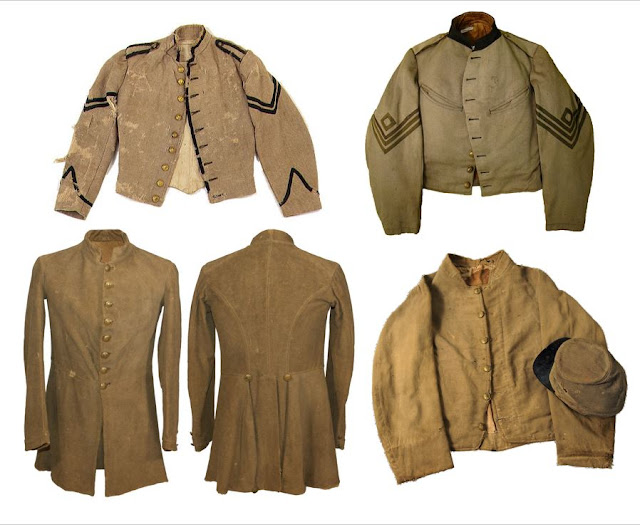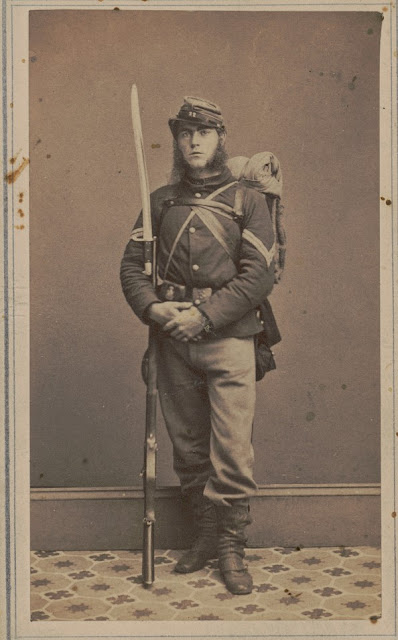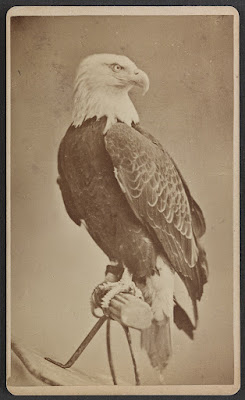Federal Arms of the Brice's Crossroads Campaign of June 1864
On June 1, 1864, General Samuel Sturgis led an expedition totaling about 10,000 men in northern Mississippi. His force consisted of twelve infantry regiments, ten cavalry regiments (or portions of regiments) and six batteries (or sections of batteries). The march lasted ten days before the resulting Battle of Brice’s Crossroads sent Sturgis’s column tumbling back towards Memphis in defeat.
A frequent question asked by students of the battle centers around the types of arms carried by the boys in Blue during this
campaign. Early in the war, state governments, scrambling to gather whatever
arms they could secure, sent their troops off to war carrying a mixture of domestic
smoothbores, converted rifled muskets, and any European arms that state agents
could procure ahead of their Federal (and Confederate) competitors. By the
summer of 1864, those days were long gone and the Federal ordnance department
had made great strides in standardizing small arms for the infantry.
The following list, compiled primarily from the first and
second quarter ordnance reports held by the National Archives, lists
out the small arms, sabers, and artillery pieces carried by the various Federal
units at Brice’s Crossroads. A few broad general statements can be made. The
infantry regiments primarily carried .58 caliber Model 1861 Springfield rifle
muskets; however, a few regiments (113th Illinois, 93rd
Indiana, 72nd Ohio, 95th Ohio, and 59th U.S.
Colored Troops) carried a mix of Springfields and P53 Enfield rifle muskets. All
of these were considered first class arms by the War Department.
The arms carried by the ten cavalry regiments proved much
more diverse and interesting. Like the artillery, several of the cavalry
regiments were deployed in detachments as opposed to full regiments. For
example, the 3rd Illinois Cavalry had four of its twelve companies
present on the expedition (B, F, I, and M), the 9th Illinois Cavalry
had eight of its twelve companies present, while the 7th Illinois
Cavalry was present in its entirety. It appears that nearly every type of
carbine in the Federal catalog was present at the battle, a veritable
cornucopia of Sharps, Burnsides, Merrill’s, Cosmopolitans, Gallagher’s, Gibbs, and
Starr carbines. As the war progressed, Federal cavalry units increasingly
turned to repeating arms and the 9th Illinois Cavalry carried .54 caliber
Colts’ revolving rifles, while the 2nd New Jersey Cavalry carried
.52 caliber Spencer carbines.
For close range combat, most (but not all) cavalrymen carried
revolvers and sabers. The legendary .44 caliber Colt Army revolver was the most
common at Brice’s Crossroads, but there were also large numbers of .36 caliber
Beals’ revolvers, .36 caliber Whitney revolvers, .36 caliber Colt Navies, and .44
caliber Remingtons. For truly close-range action, ten members of the 4th
Iowa Cavalry even carried .54 caliber single-shot Derringers! The 2nd
New Jersey, however, didn’t carry (or report) any revolvers at all. Interestingly,
the old Model 1840 dragoon saber, derisively called the “wrist-breaker” due to
its unwieldiness, was by far the most common saber carried by Federal cavalrymen
at Brice’s Crossroads although several companies carried the handier Model 1860
light cavalry saber.
The organization of Federal artillery in this campaign can be a
bit perplexing. The artillery contingent of Sturgis’s expedition consisted of
22 guns, but only Battery B of the 2nd Illinois Light Artillery was
present at its full strength of four guns. Battery E of the 1st
Illinois Light Artillery had four guns of its six guns on the field, amounting
to two sections. The remaining batteries only had single sections of two guns
each on the field: 6th Indiana Battery, 14th Indiana
Battery, Battery F of the 2nd U.S. Colored Troops Light Artillery,
and 7th Wisconsin Battery. This totals 16 guns; however, both the 4th
Missouri Cavalry and 10th Missouri Cavalry had artillery pieces, too;
the 4th Missouri carrying four mountain howitzers while the 10th
Missouri had two pieces of unknown description, but most likely mountain
howitzers, too.
Determining exactly what types of cannons were utilized at Brice’s Crossroads proved challenging; the expedition lost 16 of its 22 guns and the Q2 reports generally show what was left of the batteries after the expedition; reviewing prior reports was helpful in filling in the gaps but knowing which of the guns was lost proved difficult. For Battery F, 2nd U.S., ordnance records were incomplete so it is unknown what type of ordnance this battery used during the expedition.
 |
| Private George Kimbrue, Co. C, 93rd Indiana Infantry |
81st Illinois Infantry- .58 caliber Model 1861 Springfield rifle muskets
95th Illinois Infantry- .58 caliber Model 1861 Springfield rifle muskets
108th Illinois Infantry- .58 caliber Model 1861 Springfield rifle muskets
113th Illinois Infantry- mixed: 444 .58 caliber Model 1861 Springfield rifle muskets, 133 .577 caliber P53 Enfield rifle muskets
114th Illinois Infantry- .58 caliber Model 1861 Springfield rifle muskets
120th Illinois Infantry- .58 caliber Model 1861 Springfield rifle muskets
Battery
E, 1st Illinois Light Artillery- 6-gun battery (4 guns at battle)
Three M1857 12-pdr Napoleons, one 3” 6-pdr James rifle
Battery
B, 2nd Illinois Light Artillery- 4-gun battery
As of October 29, 1863, four 6-pdr James’ rifles
 |
| Model 1861 Springfield rifle musket |
3rd
Illinois Cavalry- 4 companies at Brice’s Crossroads
*Note: a
few companies had a sprinkling of .36 caliber Colt Navy revolvers
Co. B- .54
caliber Burnside carbines, .52 caliber Sharps’ carbines, .44 caliber Colt army revolvers,
M1860 light cavalry sabers
Co. F- .54 caliber Burnside carbines and .52 caliber Sharps’ carbines, .44 caliber Colt army revolvers, M1840 dragoon (heavy cavalry) sabers
Co. I- .54 caliber Burnside carbines, .44 caliber Colt army revolvers, .36 caliber Beals’ revolvers, M1860 light cavalry sabers
Co. M- .52 caliber Sharps’ carbines, .44 caliber Colt army revolvers, no sabers listed
7th Illinois Cavalry- .52 caliber Sharps’ carbines, mix of .36 caliber Whitney’s Navy revolvers and .36 caliber Beals’ revolvers, mostly M1840 dragoon (heavy cavalry) sabers with several companies carrying M1860 light cavalry sabers
9th
Illinois Cavalry- 8 companies at Brice’s Crossroads
Co. B- .54
caliber Colt’s revolving rifles, a few .52 caliber Sharps’ carbines, a few .36
caliber Colt Navy revolvers
Co. E- .54
caliber Colt’s revolving rifles, a few .36 caliber Colt Navy revolvers
Co. F- .54
caliber Colt’s revolving rifles, a few .36 caliber Colt Navy revolvers, a few
M1840 dragoon (heavy cavalry) sabers
Co. H- no
report
Co. I- .54
caliber Colt’s revolving rifles, .36 caliber Colt Navy revolvers
Co. K- a few
.54 caliber Colt’s revolving rifles, a few .52 Hall’s carbines, .52 caliber
Sharps’ carbines, .36 caliber Colt Navy revolvers, a few. 36 caliber Beals’
revolvers, M1860 light cavalry sabers
Co. L- .54
caliber Colt’s revolving rifles, a few .52 caliber Sharps’ carbines, .36
caliber Colt Navy revolvers, a few. 36 caliber Beals’ revolvers, M1840 dragoon
(heavy cavalry) sabers
Co. M- .54 caliber Colt’s revolving rifles, a few .36 caliber Colt Navy revolvers, a few. 36 caliber Beals’ revolvers
93rd Indiana Infantry- mixed as follows: 233 .58 caliber Model 1861 Springfield rifle muskets, 118 .577 caliber P53 Enfield rifle muskets
7th Indiana Cavalry- .54 caliber Merrill’s carbines, .44 caliber Colt Army revolvers, mostly M1840 dragoon (heavy cavalry) sabers with Co. H carrying M1860 light cavalry sabers
6th
Indiana Battery-
4-gun battery (2 guns at battle)
Two M1841 6-pdr field guns
14th
Indiana Battery- 4-gun battery (2 guns at battle)
Per May 17, 1864, three M1857 12-pdr Napoleons and one 3” Ordnance rifle
 |
| .54 caliber Burnside carbine |
3rd
Iowa Cavalry- Mixed as follows:
Co. A- .54
caliber Burnside carbines, .44 caliber Colt Army revolvers, a few .36 Beals’
revolvers, M1840 dragoon (heavy cavalry) sabers
Co. D- .54
caliber Burnside carbines, .36 caliber Colt Navy revolvers, M1840 dragoon
(heavy cavalry) sabers
Co. E- .54
caliber Burnside carbines, .36 caliber Colt Navy revolvers, M1840 dragoon
(heavy cavalry) sabers
Co. G- .54
caliber Burnside carbines, .36 caliber Colt Navy revolvers, M1840 dragoon
(heavy cavalry) sabers
Co. H- .54
caliber Burnside carbines, .36 caliber Colt Navy revolvers, a few .36 caliber
Remington revolvers, M1860 light cavalry sabers
Co. I- .54
caliber Burnside carbines, .36 caliber Beals’ revolvers, M1840 dragoon (heavy
cavalry) sabers
Co. K- .54
caliber Burnside carbines, .36 caliber Beals’ revolvers, M1860 light cavalry
sabers
Co. L- .54
caliber Burnside carbines, .36 caliber Colt Navy revolvers, a few .36 caliber
Remington revolvers, M1860 light cavalry sabers
Co. M- .54 caliber Burnside carbines, .36 caliber Colt Navy revolvers, M1860 light cavalry sabers
4th Iowa Cavalry: mixed including .52 caliber Spencer carbines (all listed as in storage), .52 caliber Cosmopolitan carbines, a few .51 caliber Gallagher carbines (Co. H only), a few .52 caliber Gibbs’ carbines (Co. M only), 339 .44 caliber Colt Army revolvers, 166 .44 caliber Remington revolvers, a few .45 caliber Starr revolvers, 10 .54 caliber Derringer pistols, a few heavy and light cavalry sabers
9th Minnesota Infantry- .58 caliber M1861 Springfield rifle muskets
4th
Missouri Cavalry- Mixed as follows:
4 M1841 12-pdr mountain howitzers
Co. B- .52
caliber Sharps’ carbines, .44 caliber Colt Army revolvers, a few .44 caliber
Remington revolvers, a few .36 caliber Remington revolvers, a few .36 caliber
Beals’ revolvers, M1840 dragoon (heavy cavalry) sabers, four Mountain Howitzers
Co. D- .51
caliber Gallagher’s carbines, .52 caliber Sharps’ carbines, .44 caliber Colt
Army revolvers, .44 caliber Remington revolvers, a few .36 caliber Beals’
revolvers, M1840 dragoon (heavy cavalry) sabers
Co. F- .51
caliber Gallagher’s carbines, .36 caliber Colt Navy revolvers, M1840 dragoon
(heavy cavalry) sabers
Co. G- .51
caliber Gallagher’s carbines, .52 caliber Sharps’ carbines, .44 caliber Colt
Army revolvers, .36 caliber Remington revolvers, a few .36 caliber Beals’
revolvers, M1840 dragoon (heavy cavalry) sabers
Co. H- .51
caliber Gallagher’s carbines, .52 caliber Sharps’ carbines, .44 caliber Colt
Army revolvers, a few .44 caliber Remington revolvers, M1860 light cavalry
sabers
Co. I- .51
caliber Gallagher’s carbines, .52 caliber Sharps’ carbines, .44 caliber Colt
Army revolvers, .36 caliber Remington revolvers, M1840 dragoon (heavy cavalry)
sabers
Co. K- .51
caliber Gallagher’s carbines, .52 caliber Sharps’ carbines, .44 caliber Colt
Army revolvers, M1840 dragoon (heavy cavalry) sabers
Co. L- .52 caliber Sharps’ carbines, .44 caliber Colt Army revolvers, .36 caliber Colt Navy revolvers, .44 caliber Remington revolvers, M1840 dragoon (heavy cavalry) sabers
10th Missouri Cavalry-
2 6-pdr James rifled artillery pieces
.52 caliber Gibbs’ carbines, .44 caliber Colt’s Army revolvers, M1840 dragoon (heavy cavalry) sabers, with two artillery pieces
2nd New Jersey Cavalry- .52 caliber Spencer carbines, M1840 dragoon (heavy cavalry) sabers with 22 M1860 light cavalry sabers
 |
| Private Casper Miller, Co. C, 72nd Ohio |
72nd Ohio Infantry- mixed as follows: 181 M1861 Springfield rifle muskets, 18 .58 caliber M1841 Mississippi rifles, 40 .577 caliber P53 Enfield rifle muskets
95th Ohio Infantry- mixed as follows: 123 M1861 Springfield rifle muskets, 97 .577 caliber P53 Enfield rifle muskets
19th
Pennsylvania Cavalry- Mixed as follows:
Co. C- .54
caliber Starr carbines, a few .52 caliber Sharps’ carbines, M1840 dragoon
(heavy cavalry) sabers
Co. G- .54
caliber Starr carbines, .44 caliber Remington revolvers, a few .36 caliber
Whitney revolvers, M1840 dragoon (heavy cavalry) sabers
Co. H- .54
caliber Starr carbines, M1840 dragoon (heavy cavalry) sabers
Co. K- .54
caliber Starr carbines, a few .52 caliber Sharps’ carbines, M1840 dragoon
(heavy cavalry) sabers
Co. L- .54 caliber Starr carbines, a few .52 caliber Sharps’ carbines, M1860 light cavalry sabers
55th U.S. Colored Troops- .577 caliber P53 Enfield rifle muskets
59th U.S. Colored Troops- mixed as follows: 244 M1861 Springfield rifle muskets and 396 .577 caliber P53 Enfield rifle muskets
Battery
F, 2nd U.S. Light Artillery Colored Troops- 2-gun battery
Two M1841 12-pdr howitzers
7th
Wisconsin Battery- 2-gun battery
Only right section of battery was at battle, armed with two M1841 6-pdr rifled guns which were lost
Two M1841
6-pdr field guns (smoothbores) was all that remained of battery on July 25, 1864,
per Q2 ordnance report.










Great job-- The real question is-- being armed with Rifles and different styles of Carbines, did this fact make any difference in the outcome of the Battle. Did the soldier's comment on the capabilities or how they won or lost a Battle of Brice's Cross Roads? How were the Confederates armed? What were the tactics used in response to the fact one side had Rifles? Great Job and I applaud your efforts. I am working on Shiloh right now and the arms used there and the outcomes. Thank You Dan.
ReplyDelete